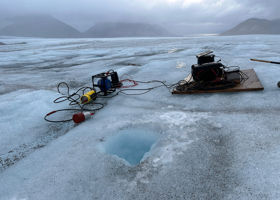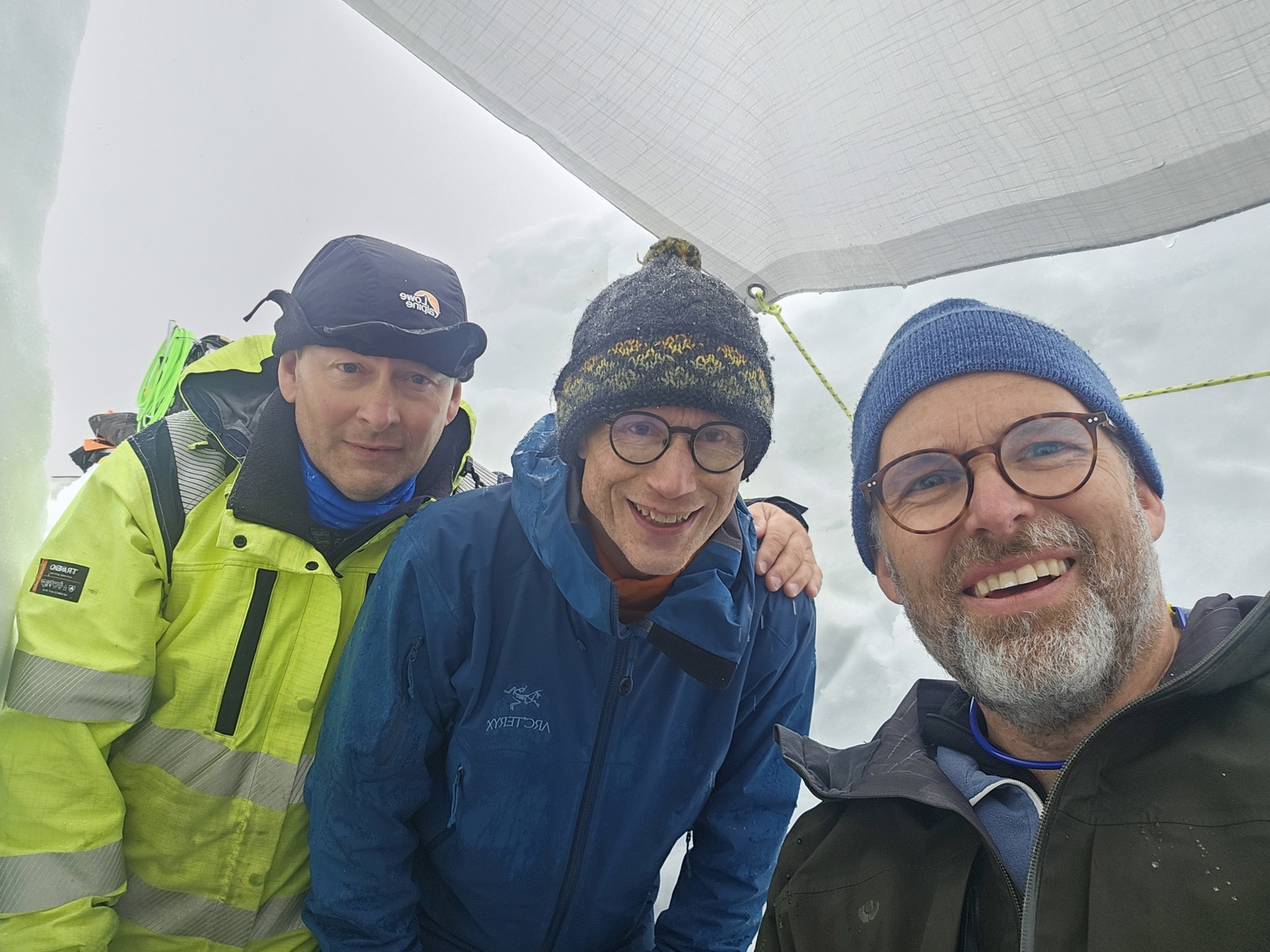Is there an optimal way to transmit data through ice?
From underneath ocean ice, through slush, warm and freezing ice?
And even from the surface of an icy moon back to Earth?
This is the challenge at the heart of a ground-breaking collaboration project between Sintef, the University of Oslo, NTNU, NASA, the Norwegian Polar Institute, Mustad Autoline, and Kongsberg Discovery.
This is SubZeroSpace.

Communicating data through frozen depths
SubZeroSpace brings together each partner's collective talents, resources and networks to solve a challenge that impacts the effective communication of data worldwide, and beyond. Combining multiple innovative technologies introduces powerful new means of communication and enhances safety in icy environments.
-
Text:Kongsberg Discovery
Photo:Satu Innanen and Shuntaro Hata
A collaboration project between Sintef, UiO (University of Oslo), NTNU (Norwegian University of Science and Technology), NASA, Norwegian Polar Institute, Mustad Autoline and Kongsberg Discovery.
The goal is to find a way to communicate through ice using acoustic sensors to autonomously detect and avoid hazards near, and through, ice and water.
The results could revolutionize how research is conducted in harsh and extreme conditions.
However, ice represents challenges.
"Ice poses a significant challenge for our technology. Our technology and products are in fact developed for, tested and normally in use in water, not ice which is quite different”, explains Thor Storm Husøy, Principal Engineer, Kongsberg Discovery.

Thor Storm Husøy Principal Engineer, Kongsberg DiscoveryThere are various methods to map thick ice using radio or seismic/acoustic techniques and to communicate wirelessly underwater over long distances. However, these methods need to be adapted to address the different absorption and scattering characteristics across various ice types.
We need to develop new communication system designs, algorithms, and protocols for planned space missions and for Autonomous Underwater Vehicles (AUVs) that communicate under and through the ice for Earth operations like mapping the sea floor and finding resources in the Arctic.
Additionally, we require new technology for safety. By using acoustic sensors in and through ice and water, we can enable safe navigation through ice, which is something current technology can’t achieve, he says.
Extreme testing
During this summer, a group of engineers and scientists from Sintef and Kongsberg Discovery travelled to Juvfonne, a glacier in Jotunheimen, Norway, to test scientific equipment.
“There was still a lot of snow there at that time”, Thor Husøy explains.
“Our testing involved digging a 3.5m deep hole to reach the top of the glacial ice."
"We set up a small pit for sending signals and a hole in the ice wall below, both filled with water to enable acoustic connections between the equipment and the ice."
Thank you to Klimapark 2469 for granting access to the ice tunnel at Juvfonne.

Going the distance through ice
Communication through ice is problematic, creating the need for new designs, algorithms, and protocols.
This project aims to crack the code by exploring the possibility of using acoustic sensors to autonomously detect and avoid hazards near, and through, ice and water.
Thor HusøyThis will enable vessels to detect hazards autonomously, and thereby navigate safely through ice, which is currently impossible with existing technology. We sent signals across a broad frequency range from 200 Hz to 18 kHz, aiming to determine the speed and distance of communication through ice. Specifically, we're investigating frequency response, reverberation, and background noise levels.
The tests were successful, yielding interesting data for further analysis.
“We conducted trials with cNODE and cPAP at a frequency of 10-15 kHz over a random distance of 40 metres with good results. Using tethered fibre connections is feasible only in the shear zone of the cold layer, necessitating a mix of RF (Radio Frequency) and acoustic communication for the remaining ~25 km of ice and water. We can only use the tethered connection at the shear layer due to the pressure in the ice, the weight required to carry it to the moons, and the increased risk of cable breakage deeper down. This mix of communication methodologies requires multiple ways of compensating for different mediums, energy dissipations, and impurities that challenge communication,” he adds.
The moons Thor Husøy is talking about are Enceladus and Europa, two of the many moons orbiting Saturn and Jupiter, respectively.
"A cable that is sturdy and long enough to reach far down into the ice will probably be heavy to transport there. Therefore, it is nice to be able to look at alternatives such as acoustics", says Thor Husøy.
Scientist Tor Arne Reien from Sintef underlines the great importance of collaboration in this project:
“Though challenges are still numerous, the technology has great potential for both hazardous object detection and wireless communication. Surely this holds on Earth, and hopefully, it will on the ice-covered moons too. The mission illustrates the benefit of cooperation between the high-tech industry and research institutions like Sintef,” says Tor Arne Reien, Senior Research Scientist, Sintef.

Project continues at Svalbard
When the team returned to their base in Horten, representatives from the University of Oslo were introduced to the range of advanced technology used at Jotunheimen. The same solutions were utilised in trials in Svalbard in August.
“The ice at the glacier Kongsvegen, close to New-Ålesund in Svalbard, is much, much thicker. Its thickness is 350 m compared to the 19 m at Juvfonne. We’re eagerly anticipating the results of this expedition, “Storm Husøy comments.
“The project's findings are expected to benefit both industry and research. Efficient communication through multimode transmission and high latencies will enhance automation, making autonomous solutions viable for bandwidth-limited operations, while creating new business opportunities for Norwegian industry.”
SubZeroSpace in brief
The SubZeroSpace project commenced in 2021 and is scheduled to end in 2024. Its outcomes have the potential to significantly enhance control and decision systems, making it highly relevant for marine science and Arctic research, where observations and measurements are scarce. The project is positioned to become a landmark initiative for Norway, linking the Ocean Space initiative with Arctic exploration and NASA's quest to detect life in other oceanic worlds. The resulting technology will benefit research, and the application of Kongsberg Discovery systems for communication and detecting marine life in harsh, icy environments.
The project group is now collecting all their findings in a report which will include discoveries about the following:
- How fast is sound going through the ice?
- How much is the ice muffling the sound?
- How much background noise is there in the ice?
- The amount of data that is possible to transmit through ice
If the project continues? It depends on a set of factors, but there are plenty of secrets yet to be discovered on Earth, in the ocean, in the Arctic and in space.

From left: André Davidsen, Tor Arne Reinen (Sintef) and Thor Storm Husøy.

Upper row: Satu Innanen, Shin Sugiyama, Ingrid Kjerstad
Lower row: Shuntaro Hata, John Hult, Maiken Revheim, Thomas Vikhamar Schuler
The Arctic is characterised by distinct components consisting of water in frozen form: glaciers, snow, permafrost and iced-over water. These components together form the cryosphere. All parts of the cryosphere are sensitive to climate change, and they all play important roles in the global climate system. The Arctic is warming three times as fast as the global average. This is mainly because of melting of snow and ice exposes a darker surface and increases the amount of solar energy absorbed in these areas. This significant regional warming leads to continued loss of sea ice, melting of glaciers and of the Greenland ice cap.
Europa, a moon of Jupiter, and Enceladus, a moon of Saturn, have evidence of oceans beneath their ice crusts. A NASA experiment suggests that if these oceans support life, signatures of that life in the form of organic molecules (e.g. amino acids, nucleic acids, etc.) could survive just under the surface ice despite the harsh radiation on these worlds. If robotic landers are sent to these moons to look for life signs, they would not have to dig very deep to find amino acids that have survived being altered or destroyed by radiation. However, finding certain kinds of amino acids on Europa or Enceladus would be a potential sign of life because they are used by terrestrial life as a component to build proteins, according to a report published in July 2024 by the research team in NASA.